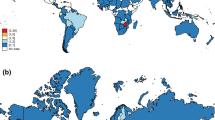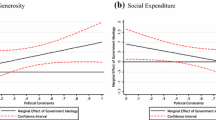Abstract
We provide a quantitative assessment of both the aggregate and the distributional effects of revoking NAFTA using a multi-country, multi-sector, multi-factor model of world production and trade with global input–output linkages. Revoking NAFTA would reduce US welfare by about 0.2%, and Canadian and Mexican welfare by about 2%. The distributional impacts of revoking NAFTA across workers in different sectors are an order of magnitude larger in all three countries, ranging from − 2.7 to 2.23% in the USA. We combine the quantitative results with information on the geographic distribution of sectoral employment, and compute average real wage changes in each US congressional district, Mexican state, and Canadian province. We then examine the political correlates of the economic effects. Congressional district-level real wage changes are negatively correlated with the Trump vote share in 2016: districts that voted more for Trump would on average experience greater real wage reductions if NAFTA is revoked.








Similar content being viewed by others
Notes
The exception to this empirical regularity are congressional districts with a large share of mining and quarrying in employment, such as the Texas 11th congressional district, or the state of Wyoming.
Section 6.1 presents the results when factors are mobile across sectors, a scenario intended to capture the long-run outcomes.
The latest WIOD release does not include worker breakdowns by skill. For that information, we use the previous (2011) WIOD release, with skill-specific sectoral labor data pertaining to 2009.
de Gortari (2019) shows that according to the Mexican firm-level customs data, the input linkages between Mexico and the USA are in fact greater than what is implied by the WIOD, and that a NAFTA trade war would have even larger negative consequences. By using WIOD, our approach is thus conservative and if anything understates the overall impact of NAFTA revocation.
We extract tariff data directly at the ISIC Rev. 3 sectoral level, and use a correspondence to ISIC Rev. 3.1 and then ISIC Rev. 4, to match it with the WIOD data classification.
References
Artuç, Erhan, Shubham Chaudhuri, and John McLaren. 2010. Trade Shocks and Labor Adjustment: A Structural Empirical Approach. American Economic Review 100(3):1008–45.
Autor, David H., David Dorn, and Gordon H. Hanson. 2013. The China Syndrome: Local Labor Market Effects of Import Competition in the United States. American Economic Review 103(6):2121–68.
Caliendo, Lorenzo, and Fernando Parro. 2015. Estimates of the Trade and Welfare Effects of NAFTA. Review of Economic Studies 82(1):1–44.
Costinot, Arnaud, and Andrés Rodríguez-Clare. 2014. Trade Theory with Numbers: Quantifying the Consequences of Globalization, Chapter 4. In Handbook of International Economics, 4, ed. Gita Gopinath, Elhanan Helpman, and Kenneth Rogoff, 197–261. Amsterdam: Elsevier.
de Gortari, Alonso. 2019. Disentangling Global Value Chains. Dartmouth: Mimeo.
Deardorff, Alan V., and Robert M. Stern. 1990. Computational Analysis of Global Trading Arrangements. Ann Arbor: The University of Michigan Press.
Dekle, Robert, Jonathan Eaton, and Samuel Kortum. 2008. Global Rebalancing with Gravity: Measuring the Burden of Adjustment. IMF Staff Papers 55(3):511–540.
Dhingra, Swati, Hanwei Huang, Gianmarco Ottaviano, João Paulo Pessoa, Thomas Sampson, and John Van Reenen. 2017. The Costs and Benefits of Leaving the EU: Trade Effects. Economic Policy 32(92):651–705.
Dix-Carneiro, Raphael. 2014. Trade Liberalization and Labor Market Dynamics. Econometrica 83(3):825–885.
Eaton, Jonathan, and Samuel S. Kortum. 2002. Technology, Geography, and Trade. Econometrica 70(5):1741–1779.
Felbermayr, Gabriel, Marina Steininger, Erdal Yalcin, et al. 2017. Global Impact of a Protectionist US Trade Policy. Munich: ifo Forschungsberichte.
Galle, Simon, Andrés Rodríguez-Clare, and Moises Yi. 2017. Slicing the Pie: Quantifying the Aggregate and Distributional Effects of Trade. New York: Mimeo, BI Norwegian Business School, UC Berkeley, and US Census Bureau.
Harrison, Glenn W., Thomas F. Rutherford, and David G. Tarr. 1997. Quantifying the Uruguay Round. The Economic Journal 107(444):1405–1430.
Hertel, Thomas W. (ed.). 1997. Global Trade Analysis: Modeling and Applications. New York: Cambridge University Press.
Jones, Ronald. 1971. A Three-Factor Model in Theory, Trade, and History. In Trade, Balance of Payments, and Growth: Papers in International Economics in Honor of Charles P, ed. Jagdish Bhagwati. Kindleberger. Amsterdam: North Holland.
Levchenko, Andrei A., and Jing Zhang. 2013. The Global Labor Market Impact of Emerging Giants: A Quantitative Assessment. IMF Economic Review 61(3):479–519.
Levchenko, Andrei A., and Jing Zhang. 2016. The Evolution of Comparative Advantage: Measurement and Welfare Implications. Journal of Monetary Economics 78:96–111.
Mussa, Michael. 1974. Tariffs and the Distribution of Income: The Importance of Factor Specificity, Substitutability, an Intensity in the Short and Long Run. Journal of Political Economy 82:1191–1203.
Timmer, Marcel P., Erik Dietzenbacher, Bart Los, Robert Stehrer, and Gaaitzen J. de Vries. 2015. An Illustrated User Guide to the World Input–Output Database: The Case of Global Automotive Production. Review of International Economics 23(3):575–605.
Acknowledgements
We are grateful to our discussant Kei-Mu Yi, Stijn Claessens and workshop participants at the BIS, the IMF ARC, University of Bayreuth and the Standing Field Committee in International Economics at the Verein für Socialpolitik for helpful comments, and to Julieta Contreras for excellent research assistance. The views expressed in this study do not necessarily reflect those of the Bank for International Settlements.
Author information
Authors and Affiliations
Corresponding author
Additional information
Publisher's Note
Springer Nature remains neutral with regard to jurisdictional claims in published maps and institutional affiliations.
Appendix: Solution Algorithm
Appendix: Solution Algorithm
To solve Eqs. (8)–(15) start by guessing \(\{{\hat{w}}_{jn},{\hat{r}}_{jn}\}\) and use the following algorithm.
- (i)
Solve for \({\hat{p}}_{jn}\) using Eqs. (14) and (12):
$$\begin{aligned} {\hat{p}}_{jn}= & {} \bigg (\sum _{m=1}^{N}\pi _{j,mn}({\hat{c}}_{jm}{\hat{\kappa }}_{j,mn})^{-\theta }\bigg )^{-\frac{1}{\theta }}\\ {\hat{p}}_{jn}= & {} \bigg [\sum _{m=1}^{N}\pi _{j,mn}^{j}\bigg (\big ({\hat{w}}_{jm}^{\alpha _{jm}}{\hat{r}}_{jm}^{1-\alpha _{jm}}\big )^{\beta _{jm}}\big (\prod _{i=1}^{J}({\hat{p}}_{im})^{\gamma _{ij,m}}\big )^{1-\beta _{im}}{\hat{\kappa }}_{j,mn}\bigg )^{-\theta }\bigg ]^{-\frac{1}{\theta }} \end{aligned}$$which can be solved iteratively. Then use \({\hat{p}}_{jn}\) to solve for \({\hat{c}}_{jn}\) and \({\hat{P}}_{n}\):
$$\begin{aligned} {\hat{c}}_{jn}= & {} ({\hat{w}}_{jn}^{\alpha _{jn}}{\hat{r}}_{jn}^{1-\alpha _{jn}})^{\beta _{jn}}\big (\prod _{i=1}^{J}({\hat{p}}_{in})^{\gamma _{ij,n}}\big )^{1-\beta _{jn}}\\ {\hat{P}}_{n}= & {} \prod _{j=1}^{J}\big ({\hat{p}}_{jn}\big )^{\xi _{jn}} \end{aligned}$$ - (ii)
Solve for \({\hat{\pi }}_{j,mn}\) using Eq. (11) and \({\hat{c}}_{jn}\):
$$\begin{aligned} {\hat{\pi }}_{j,mn}=\frac{({\hat{c}}_{jm}{\hat{\kappa }}_{j,mn})^{-\theta }}{\sum _{m'=1}^{N}\pi _{j,m'n}({\hat{c}}_{jm'}{\hat{\kappa }}_{j,m'n})^{-\theta }} \end{aligned}$$ - (iii)
Use Eqs. (8) and (9) to solve for \({\hat{Y}}_{jn}\) and \({\hat{Q}}_{jn}\):
$$\begin{aligned} {\hat{p}}_{jn}{\hat{Y}}_{jn}= & {} \sum _{i=1}^{J}{\widehat{w}}{}_{in}SL_{in}+\sum _{i=1}^{J}{\widehat{r}}{}_{in}SK_{in}+\sum _{m\ne n}\sum _{i=1}^{J}\frac{\tau '_{i,mn}{\widehat{\pi }}{}_{i,mn}{\widehat{p}}{}_{in}{\widehat{Q}}{}_{in}}{1+\tau '{}_{i,mn}}\frac{\pi {}_{i,mn}p{}_{in}Q{}_{in}}{I_{n}}+{\widehat{D}}{}_{n}SD_{n} {\hat{p}}_{jn}{\hat{Q}}_{jn}(p_{jn}Q_{jn})= & {} {\hat{p}}_{jn}{\hat{Y}}_{jn}(p_{jn}Y_{jn})+\sum _{i=1}^{J}(1-\beta _{in})\gamma _{ji,n}\Big (\sum _{m=1}^{N}\frac{{\hat{\pi }}_{i,nm}\pi _{i,nm}{\hat{p}}_{im}{\hat{Q}}_{im}(p_{im}Q_{im})}{(1+\tau '_{i,nm})}\Big ) \end{aligned}$$This can be solved iteratively.
- (iv)
Update the next guess for \({\hat{w}}_{jn}\), \({\hat{r}}_{jn}\) from the labor market clearing condition
$$\begin{aligned} {\widehat{w}}{}_{jn}={\widehat{r}}{}_{jn}= & {} \frac{\sum _{m=1}^{N}\frac{{\widehat{\pi }}{}_{j,nm}{\widehat{p}}{}_{jm}{\widehat{Q}}{}_{jm}\pi {}_{j,nm}p{}_{jm}Q{}_{jm}}{1+\tau '_{j,nm}}}{\sum _{m=1}^{N}\frac{\pi _{j,nm}p_{jm}Q_{jm}}{1+\tau _{j,nm}}}. \end{aligned}$$the solution is defined up to a numeraire, and in updating the \({\hat{w}}_{jn}\) and \({\hat{r}}_{jn}\)’s, re-set a numeraire country’s \({\hat{w}}_{1}=1\) (where country 1, sector 1 is the numeraire). Then, the actual next guess to be returned to step 1 is:
$$\begin{aligned} {\hat{w}}_{jn}^{\rm next}= & {} \frac{\hat{\tilde{w}}_{jn}^{\rm next}}{\hat{\tilde{w}}_{11}^{\rm next}} \end{aligned}$$(25)$$\begin{aligned} {\hat{r}}_{jn}^{\rm next}= & {} \frac{\hat{\tilde{r}}_{jn}^{\rm next}}{\hat{\tilde{w}}_{11}^{\rm next}} \end{aligned}$$(26)
See Figs. 9, 10, 11 and Tables 7, 8, 9, and 10.
Real wage changes and 2016 trump vote share, \(\theta =2.5\). Notes: This figure depicts the scatterplots of the average real wage change from revoking NAFTA and the 2016 Trump vote share by congressional district (left side) and state (right side), along the OLS fit. The boxes report the coefficient, robust standard error, and the \(R^{2}\) of the bivariate regression. The model is solved under \(\theta =2.5\)
Real wage changes and 2016 trump vote share, \(\theta =8\). Notes: This figure depicts the scatterplots of the average real wage change from revoking NAFTA and the 2016 Trump vote share by congressional district (left side) and state (right side), along the OLS fit. The boxes report the coefficient, robust standard error, and the \(R^{2}\) of the bivariate regression. The model is solved under \(\theta =8\)
Real wage changes and the difference between 2016 trump vote share and the 2012 romney vote share. Notes: This figure depicts the scatterplots of the average real wage change from revoking NAFTA and the difference between the 2016 Trump vote share and the 2012 Romney vote share by congressional district (left side) and state (right side), along the OLS fit. The boxes report the coefficient, robust standard error, and the \(R^{2}\) of the bivariate regression







